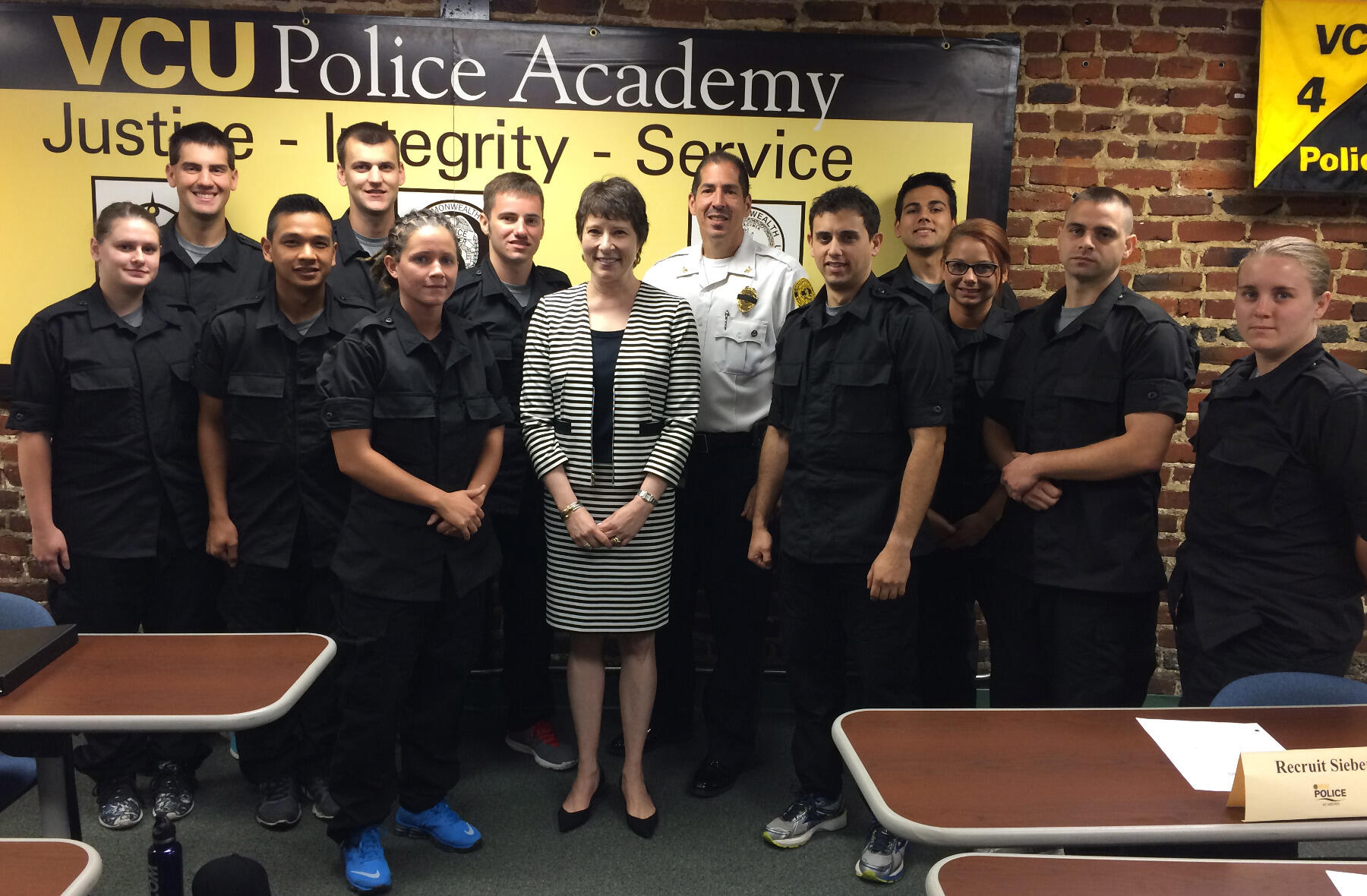July 13, 2016
VCU Police Academy recruits use art analysis to build critical inquiry skills
Share this story

The participants split into teams of two — one person to describe an image on the screen, the other to draw a sketch based on their partner’s description. The instructions were simple, Amy Herman said, but simple does not mean easy.
“This is about conveying information in a short period of time,” Herman said to the room of Virginia Commonwealth University Police Academy recruits. “This is about your ability to assess, analyze and articulate, and how well you listen. You’re going to have one minute to do this.”
Herman showed the recruits the first image — blocks of frozen vegetables stacked together. It is amazing the amount of detail in such a simple visual, she said.
Then things got weird.
The second image was a photo of a truss bridge with a 15-ton sculpture perched on top of it.
The third was a surrealist painting of a train locomotive emerging from the center of a fireplace. The locomotive was suspended in midair.
The recruits tried to describe what they were seeing. Some focused on areas of the image easier to comprehend, finding it difficult to articulate the more bizarre elements.
“But here is the problem with ignoring that information: When your partner looks up at the slide, that thing is not going to go away,” Herman said. “They are going to notice it. Think about this as you apply it to the job: You are aware of a situation and you don’t know what it is. Don’t ignore it. Maybe it’s substantial. Either way, it still exists.”
The exercise was part of a half-day training Herman facilitated Monday for VCU Police Academy recruits. VCUPD officers and administrative staff and staff from the VCU Institute of Contemporary Arts also attended the workshop. Herman’s program, The Art of Perception, involves participants analyzing works of art to build their skills of critical inquiry and articulation. Those skills are especially important for law enforcement professionals who need to quickly exchange critical information.
“Amy's program is about changing the way that things are looked at because that will change what you see,” VCU Police Chief John Venuti said. “Law enforcement has been experiencing a paradigm shift. Changing how we as a profession look at things will, in fact, change what my officers see. This can lead to more many more positive contacts involving the police and the community that we serve.”
Herman, a lawyer and art historian by trade, originally designed and developed the sessions for medical school students. In 2004, she began working with the New York City Police Department, beginning a decade-plus-long partnership with law enforcement. She also works with the intelligence community and in business and education.
“I realized there was much broader applicability. It went far beyond medicine,” Herman said. “There is a need for this kind of training. I want people to be more effective communicators of their observations. I’m asking people to really think about their communication skills but in the process to rethink their observations, perceptions and inferences as well.”
She uses slideshows of photos, paintings, sculptures and graphic arts as visual tools. In one example Monday, she demonstrated the difference between seeing and observing using an image of an older black woman and a white baby. Observational descriptions of the image can help build a cache of possible narratives, Herman said, as the recruits noted aloud what the subjects in the image were wearing, their facial expressions, estimated ages and the setting for the photo.
But it is easy to try to be too clever, Herman added. She once showed the image at a training for hospital staff and had a nurse draw conclusions without evidence.
You are accountable for every step and every detail.
“She said the kid in the picture has a thyroid condition,” Herman said. “And I asked why she thought he had a thyroid condition, and she said, ‘He has a compressed neck from multiple surgeries.’”
The child in the photo is Herman’s son. He doesn’t have a thyroid condition.
“The lesson here: Do not reach for what you want to see,” Herman said. “Don’t try to reach the conclusion you think you need to get to in order to close the case and clock out. You are accountable for every step and every detail.”
Subscribe for free to the weekly VCU News email newsletter at http://newsletter.news.vcu.edu/ and receive a selection of stories, videos, photos, news clips and event listings in your inbox every Thursday.
Subscribe to VCU News
Subscribe to VCU News at newsletter.vcu.edu and receive a selection of stories, videos, photos, news clips and event listings in your inbox.






